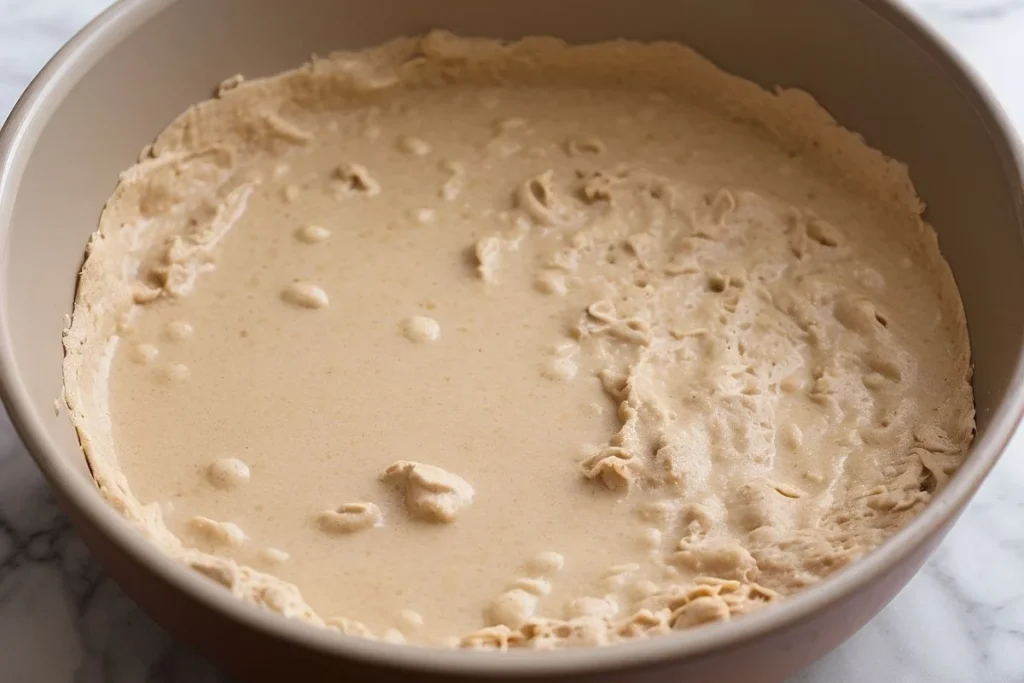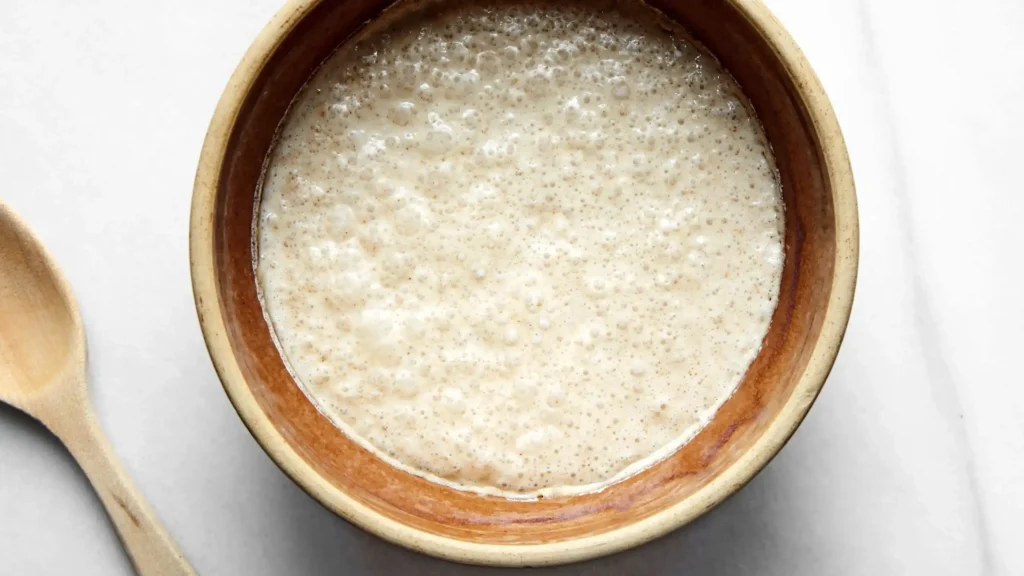
Have you ever found yourself eagerly preparing a batch of cookies only to discover that your cookie dough is disappointingly runny? Fear not! In this guide, we’ll explore the reasons behind runny cookie dough and, more importantly, how to easily fix it.
Table of Contents
ToggleWhy is My Cookie Dough Runny?
Ever been super excited about baking cookies, only to end up with runny dough instead of the perfect batch? It’s a bummer that many bakers can relate to. Let’s figure out why your cookie dough is more liquid than delicious.
- Messed-Up Measurements: One big reason for runny cookie dough is messing up the ingredient measurements. Baking is like a science experiment, and even a tiny mistake can mess up the whole recipe. Make sure to use the right measuring cups and spoons and stick to the recipe.
- Too Much Wet Stuff: The balance between wet and dry ingredients decides how your cookie dough turns out. Too much liquid, whether it’s eggs, milk, or flavor stuff, can make your dough way too soupy. Stick to the amounts in the recipe and don’t go off-script.
- Butter Temperature: Your butter’s temperature is a game-changer for your cookie dough. Soft butter is a must in many recipes, but if it’s too soft or melted, your dough might go runny. Aim for butter that’s softened but not a total mush. When in doubt, a quick chill in the fridge can help get it right.
- Don’t Mix Too Much: Mixing is important, but going overboard can mess things up. Too much stirring can make the dough stretchy and runny because of too much gluten. Just mix until everything’s combined to avoid this common issue.
- Ingredient Quality: The quality of your ingredients matters more than you’d think. If your flour or butter isn’t great, it can mess with your dough’s texture. Go for top-notch, fresh ingredients to make sure your cookie dough turns out just right.
- Flour Type: Different flours soak up liquids differently. Using the wrong flour for your recipe can make your dough too wet. Stick to the flour type mentioned in the recipe, usually all-purpose flour, for a good consistency.
- Baking Soda or Powder Trouble: Baking soda and baking powder affect how your cookies rise and feel. Using too much or too little can throw things off, making your dough runny. Double-check your measurements to be sure.
Can You Still Bake Runny Cookie Dough
Wondering if your cookie dough ended up too thin? No worries! You can still bake it successfully. Just pop the dough in the fridge for around 30 minutes to make it firmer. This prevents it from spreading too much while baking, giving you cookies that are both chewy and crispy, just the way you like.
Once it’s chilled, use a scoop to place the dough on a baking sheet lined with parchment paper, and bake according to the instructions.
Keep a close watch to make sure you don’t overcook them. With a bit of patience and proper chilling, you’ll end up with delicious cookies that rival those from a bakery, even if the dough started a bit runny.

Step-by-Step Guide to Fixing Runny Cookie Dough
Fixing runny cookie dough may seem challenging, but fear not – our step-by-step guide is your roadmap to rescuing your cookies.
Follow these foolproof steps to make sure your baking turns out delicious.
- Check the Dough’s: Consistency Start by looking at your cookie dough. Is it too soft and gooey? Knowing where you’re starting from is crucial for making the right fixes.
- Chill in the Fridge: Temperature is key here. Stick the runny dough in the fridge for at least 30 minutes. This helps the butter firm up and corrects the overly soft consistency.
- Add Flour: Gradually mix in more flour. Do it bit by bit to avoid going overboard. The goal is to get the thickness you want without messing up the flavor or texture.
- Gently Knead: As you add flour, knead the dough. Make sure it’s well mixed without overdoing it. Find the balance – the right consistency without making the dough too heavy.
- Test a Small Bit: Before doing the whole batch, try a small bit. This lets you see the impact of your changes without risking the entire batch.
- Repeat if Needed: If the first fixes don’t get you the consistency you want, don’t worry. Repeat the process, making small changes until your cookie dough is perfectly moist and thick.
- Keep an Eye on Baking Time: Once you’ve fixed the runny dough, watch the baking time closely. You might need to adjust it to fit the changes in the dough’s consistency.
- Enjoy Your Perfect Cookies!: Congratulations! You’ve tackled runny cookie dough and come out on top. Enjoy the sweet success of perfectly baked cookies, ready to satisfy your taste buds.

Tips and Tricks for Preventing Runny Cookie Dough
Embarking on a baking adventure is such a fun experience, but dealing with runny cookie dough can be a real downer. As someone who loves to bake and has tackled this problem, I’m excited to share my best tips to keep your cookie dough in top shape.
Understanding the Ingredients
To avoid runny cookie dough, it’s crucial to know what each ingredient does. Flour, butter, sugar, and eggs all play a key role in the texture. Use high-quality ingredients, and measure them precisely.
Getting the flour-to-fat ratio right is especially important; it forms the basis of a perfect dough.
Chill, Chill, Chill!
A big rule for cookie dough is to chill it before baking. This not only boosts the flavors but also keeps the dough from getting too sticky. After mixing, resist the urge to start baking right away.
Instead, cover the dough and let it chill in the fridge for at least 30 minutes. This simple step works wonders to prevent runny issues.
The Art of Mixing
How you mix things can make a huge difference. Overmixing creates too much gluten, making the dough sticky and runny. To avoid this, be gentle when combining ingredients.
Mix until just combined to keep the right balance of tenderness and structure. Remember, less is often more when mixing cookie dough.
Customizing for Your Environment
Baking isn’t a one-size-fits-all thing, especially with cookie dough. Your kitchen’s temperature and humidity can affect the dough’s consistency. In warmer seasons, consider using slightly less liquid.
If your kitchen is cooler, you might need to add a bit more liquid. Adjusting your recipe to fit your environment ensures your cookie dough turns out just right.

Creative Ways to Use Runny Cookie Dough
Don’t stress over runny cookie dough; see it as a chance to get creative in the kitchen! Beyond the typical cookie shape, there are tons of fun ways to use that soft, gooey mixture.
- Cookie Dough Truffles Take small bits of the runny dough and roll them into bite-sized balls, then dunk them in melted chocolate. These cookie dough truffles have a mix of textures, with a crunchy chocolate coating giving way to a soft, cookie dough center.
- Cookie Dough Ice Cream Topping Swirl the runny cookie dough into your favorite ice cream for an instant upgrade. The smooth consistency of the dough adds a sweet ribbon, making each scoop a delightful surprise.
- Stuffed Pancakes Add some sweetness to your morning routine by using runny cookie dough as a filling for pancakes. Just spoon bits of dough onto the pancake batter as it cooks, creating pockets of gooey goodness in each flapjack.
- Cookie Dough Parfait Layer runny cookie dough with whipped cream and crumbled cookies to make a delicious cookie dough parfait. Serve it in individual glasses for a visually appealing and tasty dessert.
- Cookie Dough Filled Pastries Add some excitement to your pastries by using runny cookie dough as a filling. Whether in turnovers, croissants, or puff pastry cups, the gooey center will take your baked goods to new heights.
Can You Fix Runny Cookie Dough Without Flour?
It’s doable to fix thin cookie dough without adding flour. One way to make the dough thicker is by slowly mixing in a tablespoon of either cornstarch or arrowroot powder. Just stir it in until you get the consistency you want.
Another trick is to add a tablespoon of nut butter or ground oats. They’re good at soaking up extra moisture in the cookie dough.
If these tricks don’t work like you want them to, you can pop the cookie dough in the fridge for a few hours before baking. This helps the dough firm up, so it’s not as runny when you’re ready to bake.
Final Thoughts
In the fun world of baking, dealing with runny cookie dough can be a real downer. This guide spills the beans on what’s causing it—like messing up ingredient measurements, too much liquid, butter blunders, overmixing, and ingredient quality issues—and gives you a complete fix.
The step-by-step rescue plan, from chilling the dough to carefully adding more flour, ensures your cookies turn out perfect. Tips for avoiding future dough disasters focus on understanding your ingredients, chilling, being mindful when mixing, and adapting to your kitchen setup.
And don’t stress about the runny mishap; see it as a chance to get creative with truffles, ice cream toppings, stuffed pancakes, and filled pastries. Happy baking!
Lindsey Mackenzie
About me
Hi there! I’m Lindsey Mackenzie, the founder of Bake Smartly. Baking has been my passion since childhood, growing up in my father’s bakery. With Bake Smartly, I’m excited to share my love for all things sweet and savory. Join me on this delicious journey as we whip up scrumptious treats and sprinkle joy into every bite!






